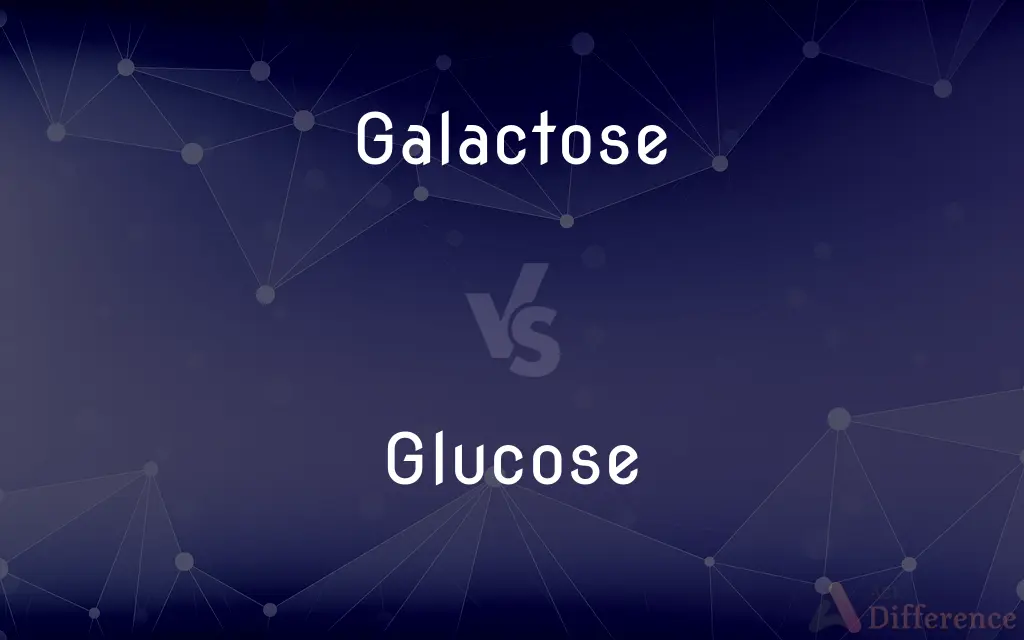Galactose vs. Glucose — What's the Difference?
By Tayyaba Rehman & Urooj Arif — Updated on March 25, 2024
Galactose is a simple sugar less sweet than glucose, often found in dairy, while glucose is a primary energy source in cells, prevalent in fruits and honey.

Difference Between Galactose and Glucose
Table of Contents
ADVERTISEMENT
Key Differences
Galactose, a monosaccharide like glucose, is a sugar molecule that plays a crucial role in the synthesis of lactose, the sugar found in milk. Unlike glucose, which is known for its direct role in energy production within cells, galactose is typically converted into glucose in the liver before it can be used for energy. This difference underscores their roles in human metabolism, with glucose serving as an immediate energy source and galactose requiring conversion.
In terms of structure, both galactose and glucose are hexoses, containing six carbon atoms, but they differ in the arrangement of hydroxyl groups (-OH) on one of their carbon atoms. This slight variation significantly impacts their chemical properties and how they interact in biological processes. While glucose is often found in a free state in fruits and honey, contributing to their sweetness, galactose rarely exists independently in nature; it is most commonly encountered as part of lactose in dairy products.
The sweetness of glucose is well-recognized, making it a key ingredient in various foods and beverages. Galactose, on the other hand, is less sweet and not commonly used as a standalone sweetener. However, when galactose combines with glucose to form lactose, it contributes to the mild sweetness of dairy products.
Glucose's central role in cellular respiration, particularly in the glycolysis pathway, highlights its importance in energy production. Galactose's metabolism involves an initial conversion to glucose or glucose-1-phosphate before it can enter these energy-yielding pathways, indicating a more indirect contribution to cellular energy needs.
Both sugars are essential in the human diet, but their metabolism and functions diverge, reflecting their distinct roles in nutritional science and metabolism. While glucose is directly tied to energy production and blood sugar regulation, galactose's significance is linked to its conversion into glucose and its role in lactose synthesis, essential for dairy nutrition.
ADVERTISEMENT
Comparison Chart
Primary Source
Dairy products (as part of lactose)
Fruits, honey, and many other foods
Sweetness
Less sweet than glucose
Highly sweet and a primary sweetener in foods
Role in Metabolism
Converted into glucose in the liver for energy
Directly used by cells for energy production
Structural Form
Rarely found free; usually part of lactose
Often found in free state or as part of other sugars
Biological Role
Part of lactose, essential for dairy nutrition
Essential for cellular respiration and energy
Compare with Definitions
Galactose
A simple sugar that combines with glucose to form lactose.
Galactose is found in milk and dairy products as a component of lactose.
Glucose
Plays a crucial role in blood sugar regulation and metabolism.
Insulin and glucagon regulate blood glucose levels, ensuring cells have a steady energy supply.
Galactose
Less sweet than glucose and not typically used as a standalone sweetener.
Galactose's mild sweetness is noticeable in milk's subtle sweetness.
Glucose
Found in a free state in fruits, honey, and many sweet foods.
The natural sweetness of fruits is largely due to their glucose content.
Galactose
Rarely found in a free state in nature; usually bound to other molecules.
In addition to lactose, galactose is a component of some complex lipids and glycoproteins.
Glucose
Used medically to provide nutritional support and in oral glucose tolerance tests.
Glucose solutions are administered intravenously to patients needing nutritional support.
Galactose
Important in the synthesis of glycoproteins and glycolipids.
Galactose is involved in the formation of cerebrosides, important components of brain and nerve cell membranes.
Glucose
Can form complex carbohydrates through polymerization.
Glucose molecules link together to form starch and cellulose, important plant carbohydrates.
Galactose
Metabolized in the liver where it is converted into glucose.
The metabolism of galactose into glucose allows it to be used for energy.
Glucose
A primary energy source for cells, central to cellular respiration.
Glucose is broken down during glycolysis to provide ATP, the energy currency of the cell.
Galactose
Galactose (, galacto- + -ose, "milk sugar") sometimes abbreviated Gal, is a monosaccharide sugar that is about as sweet as glucose, and about 65% as sweet as sucrose. It is an aldohexose and a C-4 epimer of glucose.
Glucose
Glucose is a simple sugar with the molecular formula C6H12O6. Glucose is the most abundant monosaccharide, a subcategory of carbohydrates.
Galactose
A monosaccharide, C6H12O6, commonly occurring in lactose and in certain pectins, gums, and mucilages.
Glucose
A simple sugar which is an important energy source in living organisms and is a component of many carbohydrates.
Galactose
(carbohydrate) A monosaccharide found, along with lactose, in dairy products, and is synthesized by the body where it is found associated with glycolipids and glycoproteins.
Glucose
A colorless to yellowish syrupy mixture of dextrose, maltose, and dextrins containing about 20 percent water, used in confectionery, alcoholic fermentation, tanning, and treating tobacco. Also called starch syrup.
Galactose
A white, crystalline sugar, C6H12O6, isomeric with dextrose, obtained by the decomposition of milk sugar, and also from certain gums. When oxidized it forms mucic acid. Called also lactose (though it is not lactose proper).
Glucose
(carbohydrate) A simple monosaccharide (sugar) with a molecular formula of C6H12O6; it is a principle source of energy for cellular metabolism.
Galactose
A simple sugar found in lactose
Glucose
A variety of sugar occurring in nature very abundantly, as in ripe grapes, and in honey, and produced in great quantities from starch, etc., by the action of heat and acids. It is only about half as sweet as cane sugar. Called also dextrose, grape sugar, diabetic sugar, and starch sugar. See Dextrose.
Glucose
Any one of a large class of sugars, isometric with glucose proper, and including levulose, galactose, etc.
Glucose
A monosaccharide sugar that has several forms; an important source of physiological energy
Common Curiosities
Are galactose and glucose structurally similar?
Yes, both are hexoses with six carbon atoms, but they differ in the arrangement of hydroxyl groups on one carbon atom.
What is galactose?
Galactose is a monosaccharide sugar, less sweet than glucose, primarily found in dairy products as a component of lactose.
Where is galactose commonly found?
Galactose is commonly found in dairy products, where it is bonded to glucose to form lactose.
How do galactose and glucose differ in metabolism?
Galactose is converted into glucose in the liver before it can be used for energy, while glucose is directly utilized by cells for energy production.
What role does glucose play in the body?
Glucose is crucial for cellular respiration, providing the necessary energy for cellular functions and maintaining blood sugar levels.
What happens to galactose in individuals with galactosemia?
In galactosemia, individuals lack the enzyme needed to convert galactose into glucose, leading to the accumulation of galactose in the body, which can be toxic.
Can galactose be used directly by cells for energy?
No, galactose must first be converted into glucose or glucose-1-phosphate in the liver before it can be used for energy by cells.
What is glucose?
Glucose is a simple sugar and a key energy source for cells, widely found in fruits, honey, and many other foods.
How does the sweetness of galactose compare to glucose?
Galactose is less sweet than glucose, which is a primary sweetener in various foods and beverages.
Is glucose beneficial for health?
While glucose is essential for energy, excessive intake can lead to health issues like obesity and diabetes, highlighting the importance of balance in sugar consumption.
Share Your Discovery

Previous Comparison
Puritans vs. Quakers
Next Comparison
Play vs. MusicalAuthor Spotlight
Written by
Tayyaba RehmanTayyaba Rehman is a distinguished writer, currently serving as a primary contributor to askdifference.com. As a researcher in semantics and etymology, Tayyaba's passion for the complexity of languages and their distinctions has found a perfect home on the platform. Tayyaba delves into the intricacies of language, distinguishing between commonly confused words and phrases, thereby providing clarity for readers worldwide.
Co-written by
Urooj ArifUrooj is a skilled content writer at Ask Difference, known for her exceptional ability to simplify complex topics into engaging and informative content. With a passion for research and a flair for clear, concise writing, she consistently delivers articles that resonate with our diverse audience.














































